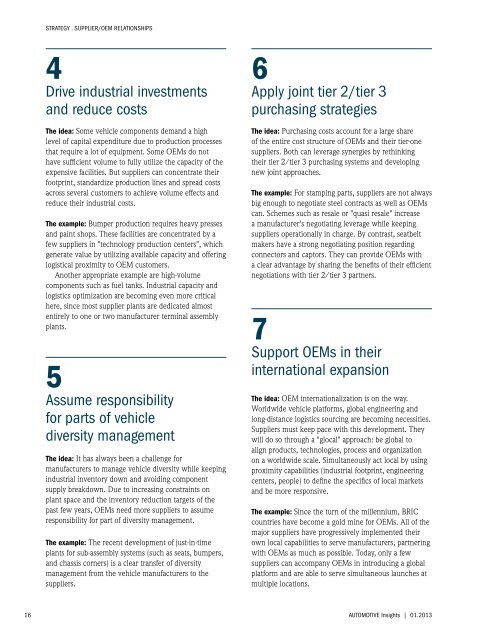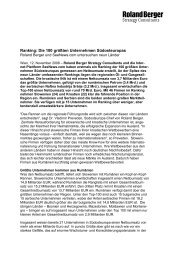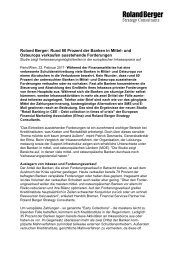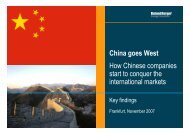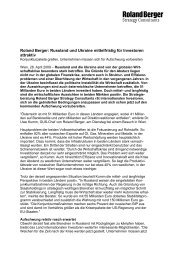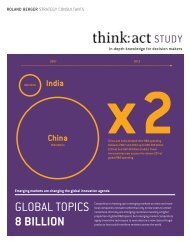Automotive Insights 01.2013 - Roland Berger
Automotive Insights 01.2013 - Roland Berger
Automotive Insights 01.2013 - Roland Berger
You also want an ePaper? Increase the reach of your titles
YUMPU automatically turns print PDFs into web optimized ePapers that Google loves.
Strategy . Supplier/OEM Relationships<br />
4<br />
Drive industrial investments<br />
and reduce costs<br />
The idea: Some vehicle components demand a high<br />
level of capital expenditure due to production processes<br />
that require a lot of equipment. Some OEMs do not<br />
have sufficient volume to fully utilize the capacity of the<br />
expensive facilities. But suppliers can concentrate their<br />
footprint, standardize production lines and spread costs<br />
across several customers to achieve volume effects and<br />
reduce their industrial costs.<br />
The example: Bumper production requires heavy presses<br />
and paint shops. These facilities are concentrated by a<br />
few suppliers in "technology production centers", which<br />
generate value by utilizing available capacity and offering<br />
logistical proximity to OEM customers.<br />
Another appropriate example are high-volume<br />
components such as fuel tanks. Industrial capacity and<br />
logistics optimization are becoming even more critical<br />
here, since most supplier plants are dedicated almost<br />
entirely to one or two manufacturer terminal assembly<br />
plants.<br />
5<br />
Assume responsibility<br />
for parts of vehicle<br />
diversity management<br />
The idea: It has always been a challenge for<br />
manufacturers to manage vehicle diversity while keeping<br />
industrial inventory down and avoiding component<br />
supply breakdown. Due to increasing constraints on<br />
plant space and the inventory reduction targets of the<br />
past few years, OEMs need more suppliers to assume<br />
responsibility for part of diversity management.<br />
The example: The recent development of just-in-time<br />
plants for sub-assembly systems (such as seats, bumpers,<br />
and chassis corners) is a clear transfer of diversity<br />
management from the vehicle manufacturers to the<br />
suppliers.<br />
6<br />
Apply joint tier 2/tier 3<br />
purchasing strategies<br />
The idea: Purchasing costs account for a large share<br />
of the entire cost structure of OEMs and their tier-one<br />
suppliers. Both can leverage synergies by rethinking<br />
their tier 2/tier 3 purchasing systems and developing<br />
new joint approaches.<br />
The example: For stamping parts, suppliers are not always<br />
big enough to negotiate steel contracts as well as OEMs<br />
can. Schemes such as resale or "quasi resale" increase<br />
a manufacturer's negotiating leverage while keeping<br />
suppliers operationally in charge. By contrast, seatbelt<br />
makers have a strong negotiating position regarding<br />
connectors and captors. They can provide OEMs with<br />
a clear advantage by sharing the benefits of their efficient<br />
negotiations with tier 2/tier 3 partners.<br />
7<br />
Support OEMs in their<br />
international expansion<br />
The idea: OEM internationalization is on the way.<br />
Worldwide vehicle platforms, global engineering and<br />
long-distance logistics sourcing are becoming necessities.<br />
Suppliers must keep pace with this development. They<br />
will do so through a "glocal" approach: be global to<br />
align products, technologies, process and organization<br />
on a worldwide scale. Simultaneously act local by using<br />
proximity capabilities (industrial footprint, engineering<br />
centers, people) to define the specifics of local markets<br />
and be more responsive.<br />
The example: Since the turn of the millennium, BRIC<br />
countries have become a gold mine for OEMs. All of the<br />
major suppliers have progressively implemented their<br />
own local capabilities to serve manufacturers, partnering<br />
with OEMs as much as possible. Today, only a few<br />
suppliers can accompany OEMs in introducing a global<br />
platform and are able to serve simultaneous launches at<br />
multiple locations.<br />
16 <strong>Automotive</strong> <strong>Insights</strong> | <strong>01.2013</strong>


